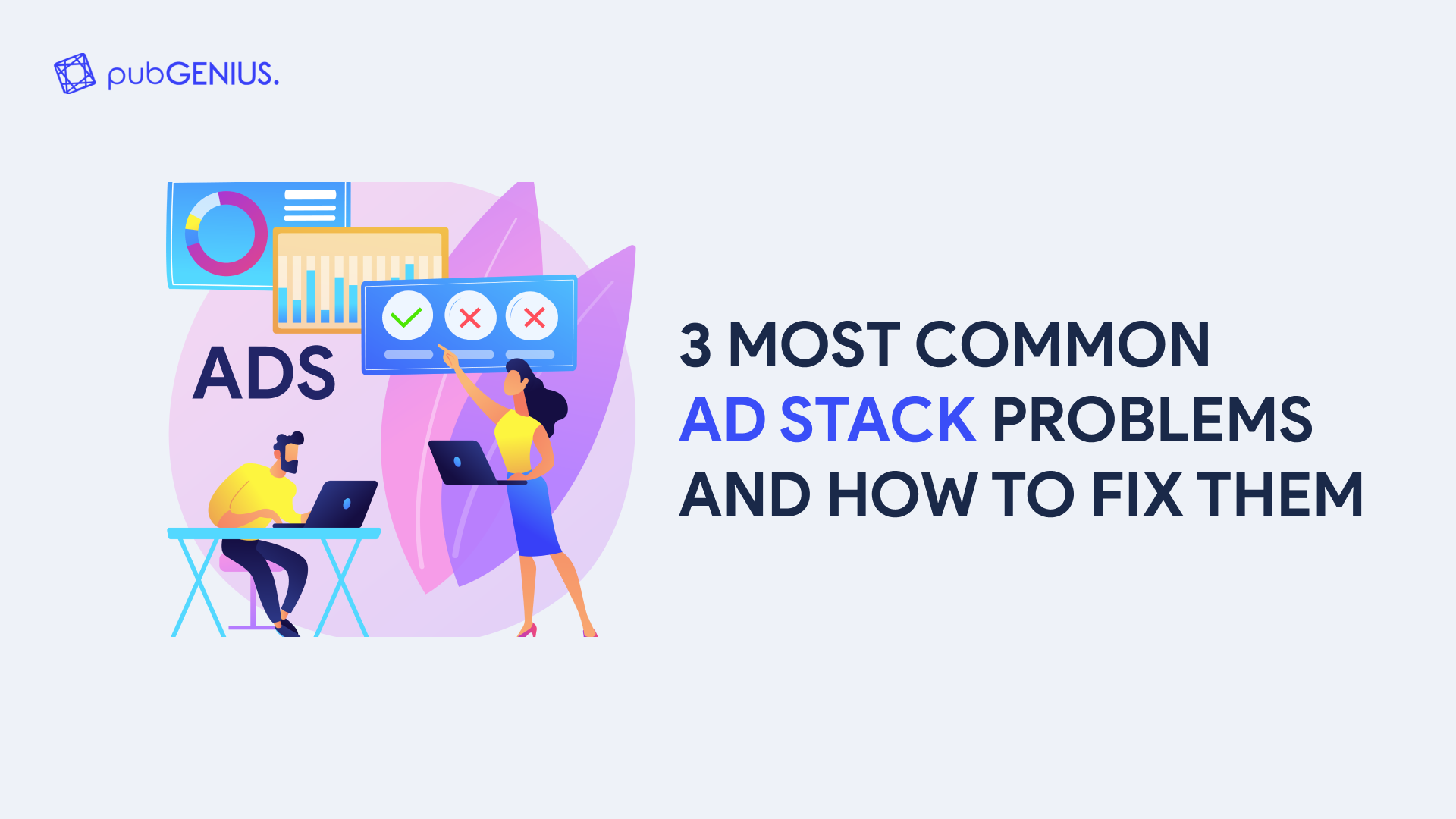3 Most Common Ad Stack Problems and How to Fix Them
November 3, 2021
Ad Stack Problems.
The ad tech industry is an increasingly crowded and competitive space. The number of multiple solutions, ad formats, technologies and platforms is growing rapidly. So it is no wonder that both publishers and advertisers are feeling confused about which technologies to choose and what strategies to implement in order to achieve the best results.
It is especially easy to get confused when it comes to composing and utilizing your ad stack. Which is totally understandable as a publisher’s ad stack can include a handful of components that need to work together. All this diversity comes with a price, often causing ad stack issues and challenges, the reasons of which can be unclear.
Let’s talk about some of the most frequent ad stack problems that publishers commonly face today.
Problem #1. Latency issues

According to the IAB definition, latency is the time it takes for a data packet to move across a network connection. When the latency occurs, it results in a visible delay between the request and the time when content and/or ad is actually displayed.
Despite all the advanced technologies and ad tech innovations popping up all the time, latency is still a major problem. According to a survey of more than 200 executives from top publishing companies, latency remains to be one of the largest issues in the programmatic advertising domain for them. Due to the fact that all the parties participating in the ad tech ecosystem—publishers, advertisers, and vendors—contribute to it, there is no simple solution to the latency issue.
Even though it is difficult for publishers to solve the latency issue on their own, here are a number of recommendations on how to deal with it.
-
Prioritize latency minimization.
It is natural for publishers to be focused on increasing their revenue by engaging their audience and loading as many ads as possible. Considering the latency issue doesn’t have a quick fix, many publishers end up ignoring it. The right approach would be to prioritize dealing with latency as part of your ad stack optimization strategy.
-
Use ad analysis tools.
The majority of publishers, especially the smaller ones, don’t have tools in their ad stack capable of identifying and blocking ad units that are causing the most latency. It is advisable to add an analytics platform to your stack to allow you to quickly identify ads with high latency. As well as identifying partners who tend to serve this kind of ads.
-
Don’t overload your pages.
Many publishers tend to overload their pages with recommendation widgets and other modules designed to engage the audience and increase the number of page views. One of the downsides of this is lower page load speed, which contributes to latency issues.
-
Minimize the RTB auctions run time.
Another contributing factor is the tendency by publishers to allow real-time auctions for their inventory to run longer as it allows them to receive more bids, driving up the price per impression. Minimizing the run time of an auction could help to deal with latency.
-
Use server-side header bidding solutions.
We have already covered the differences between client-side and server-side header bidding. In summary, server-side bidding helps to lower latency because the whole process is handled by dedicated servers.
-
Partner with ad exchanges and DSPs that update their platforms regularly.
Ad partners that use outdated technologies and are not very motivated to update them frequently can be another reason for your latency issues. Prioritize working with partners that have timely technology updates and other efforts focused on minimizing latency on their side.
Problem #2. User identification and targeting

Establishing user identity and collecting other private information to use for better targeting is a considerable problem for publishers. And it is getting more serious now, after Google announced that it would eliminate third-party cookies from Chrome by 2022.
This move towards a more private and anonymous web would also lead to additional problems in audience targeting and remarketing. Resulting in a more fragmented ad tech landscape. Even though this is primarily an advertiser’s problem, it certainly affects publishers as well. If you are not able to provide your demand partners with high-quality audience data, this would have a negative effect on the cost of your impressions.
-
Add Data Management Platforms (DMPs) to your ad stack.
As the value of user data is increasing, it would be a good idea to add a data management platform to collect, store and share audience and customer data with your ad partners. Some examples of popular DMPs would be Nielsen DMP, Oracle BlueKai, and Adobe Audience Manager.
-
Utilize machine learning and data analytics to study your audience.
You should also use various tools available today in order to study your audience as much as possible. This allows you to provide first-party data to advertisers, directly through demand platforms, for better targeting of your inventory.
-
Add a retargeting tool to your stack.
As programmatic advertising is getting more complex and dynamic, it is more difficult for consumers to absorb advertising messages from the first view. This is why the importance of retargeting capabilities is growing as well. These are some examples of popular ad retargeting tools you might want to add to your ad stack. Adroll, Criteo, SmarterHQ, Artudata, Perfect Audience, Sizmek, Retargeter, Fixel.
Problem #3. Poor ad viewability

Ad viewability measures how visible the ads are to the audience of a website or mobile app. As advertisers are looking to pay for highly viewable ad placements, poor ad viewability results in lower ad revenues.
Because of that, the requirements for ad viewability are rising. Poorly viewable ads become less successful in attracting advertisers. Today many advertisers have a minimum threshold for ad viewability in order to buy ads from a publisher. These thresholds vary from 40 to 80% on average, depending on the advertiser and KPIs. This is one of the most common and annoying ad stack problems.
-
Utilize ad viewability measurement tools.
In order to deal with this problem, you need to measure the viewability of your ads. Even though major SSPs and DSPs typically have this function as part of their platforms, it might be a good idea to add a third-party ad viewability measurement tool to your own ad stack. Here are several examples of such tools: Moat, DoubleVerify, Integral Ad Science, Pixalate, Forensiq, Fraudlogix.
-
Optimize your header bidding stack.
Poorly optimized header bidding stack can be a major contributor to poor ad viewability (as well as latency). Some of the changes that you can make are: limiting the number of bidders, adopting asynchronous loading, removing slow bidders, changing the wrapper to a faster one, setting optimal auction timeouts, etc.
-
Adopt lazy loading ads.
Lazy loading has been well-known in the online advertising domain as a method to create a better user experience and bring more value to advertisers at the same time. When active, web pages create empty placeholder containers that are replaced with content when visible on the user’s screen. Lazy loading improves ad viewability by restricting ads that are not on the user’s screen from loading.
Summary

These, of course, are just several major ad stack problems publishers are facing today. Most everything can be solved or at least minimized by changes in your ad stack and the addition of new tools to it.
Not sure where to start empowering your ad stack in order to solve these and other common problems? Allow professionals with proven expertise in the digital ads market to take care of this.
This is us! pubGENIUS’ ad ops specialists are well-versed in the best practices and trends of the industry. We know how to utilize innovative technologies and ad formats to optimize ad stacks for individual publishers. We will make sure that your websites are equipped with the most relevant tools and your ad inventory is set up and operating with maximum capacity at all times.
Get in touch with pubGENIUS Team to get free consultation 🙂
